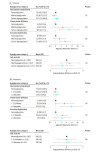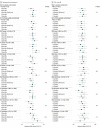Association of Neonatal Glycemia With Neurodevelopmental Outcomes at 4.5 Years
- PMID: 28783802
- PMCID: PMC5710616
- DOI: 10.1001/jamapediatrics.2017.1579
Association of Neonatal Glycemia With Neurodevelopmental Outcomes at 4.5 Years
Abstract
Importance: Hypoglycemia is common during neonatal transition and may cause permanent neurological impairment, but optimal intervention thresholds are unknown.
Objective: To test the hypothesis that neurodevelopment at 4.5 years is related to the severity and frequency of neonatal hypoglycemia.
Design, setting, and participants: The Children With Hypoglycemia and Their Later Development (CHYLD) Study is a prospective cohort investigation of moderate to late preterm and term infants born at risk of hypoglycemia. Clinicians were masked to neonatal interstitial glucose concentrations; outcome assessors were masked to neonatal glycemic status. The setting was a regional perinatal center in Hamilton, New Zealand. The study was conducted from December 2006 to November 2010. The dates of the follow-up were September 2011 to June 2015. Participants were 614 neonates born from 32 weeks' gestation with at least 1 risk factor for hypoglycemia, including diabetic mother, preterm, small, large, or acute illness. Blood and masked interstitial glucose concentrations were measured for up to 7 days after birth. Infants with hypoglycemia (whole-blood glucose concentration <47 mg/dL) were treated to maintain blood glucose concentration of at least 47 mg/dL.
Exposures: Neonatal hypoglycemic episode, defined as at least 1 consecutive blood glucose concentration less than 47 mg/dL, a severe episode (<36 mg/dL), or recurrent (≥3 episodes). An interstitial episode was defined as an interstitial glucose concentration less than 47 mg/dL for at least 10 minutes.
Main outcomes and measures: Cognitive function, executive function, visual function, and motor function were assessed at 4.5 years. The primary outcome was neurosensory impairment, defined as poor performance in one or more domains.
Results: In total, 477 of 604 eligible children (79.0%) were assessed. Their mean (SD) age at the time of assessment was 4.5 (0.1) years, and 228 (47.8%) were female. Those exposed to neonatal hypoglycemia (280 [58.7%]) did not have increased risk of neurosensory impairment (risk difference [RD], 0.01; 95% CI, -0.07 to 0.10 and risk ratio [RR], 0.96; 95% CI, 0.77 to 1.21). However, hypoglycemia was associated with increased risk of low executive function (RD, 0.05; 95% CI, 0.01 to 0.10 and RR, 2.32; 95% CI, 1.17 to 4.59) and visual motor function (RD, 0.03; 95% CI, 0.01 to 0.06 and RR, 3.67; 95% CI, 1.15 to 11.69), with highest risk in children exposed to severe, recurrent, or clinically undetected (interstitial episodes only) hypoglycemia.
Conclusions and relevance: Neonatal hypoglycemia was not associated with increased risk of combined neurosensory impairment at 4.5 years but was associated with a dose-dependent increased risk of poor executive function and visual motor function, even if not detected clinically, and may thus influence later learning. Randomized trials are needed to determine optimal screening and intervention thresholds based on assessment of neurodevelopment at least to school age.
Conflict of interest statement
Figures



Comment in
-
Neonatal hypoglycemia: is there a neurodevelopmental impact in early childhood?J Perinatol. 2019 Jan;39(1):4-7. doi: 10.1038/s41372-018-0244-2. Epub 2018 Oct 10. J Perinatol. 2019. PMID: 30305715 No abstract available.
References
-
- Adamkin DH; Committee on Fetus and Newborn . Postnatal glucose homeostasis in late-preterm and term infants. Pediatrics. 2011;127(3):575-579. - PubMed
-
- Kaiser JR, Bai S, Gibson N, et al. . Association between transient newborn hypoglycemia and fourth-grade achievement test proficiency: a population-based study. JAMA Pediatr. 2015;169(10):913-921. - PubMed
-
- Kerstjens JM, Bocca-Tjeertes IF, de Winter AF, Reijneveld SA, Bos AF. Neonatal morbidities and developmental delay in moderately preterm-born children. Pediatrics. 2012;130(2):e265-e272. - PubMed
Publication types
MeSH terms
Substances
LinkOut - more resources
Full Text Sources
Other Literature Sources
Medical
Miscellaneous

